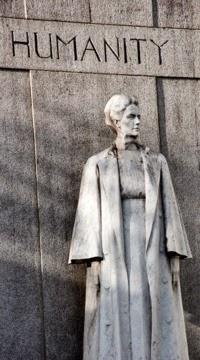London Walks Pen & Daily Constitutional Special Correspondent David Tucker pauses by a statue hidden in plain view (continued from yesterday)...

Why was Edith Cavell executed? She was running a clinic and nurse's training school in Brussels. She was helping British soldiers to escape. They were often disguised as patients. The Germans became suspicious. They began to pay "visits" to the clinic.
Cavell was arrested on August 5. Along with several others. She was put in solitary confinement. She made a statement. It amount to a confession. It named some of her accomplices. On October 7 nine people were court martialled. Five were found guilty of assisting the enemy and damaging the German war effort. They were sentenced to death. Their four co-defendants to hard labour. The death sentences of three of the condemned were commuted. But not Cavell's or Phillip Baucq's (he was the leader of the resistance movement).
Anything else? Sure, it's London. There's always something else. In this instance four odds and ends. For good measure.
1.The statue was unveiled by Queen Alexandra on March 17, 1920. Danish by birth, Alexandra loathed her nephew, Kaiser Wilhelm. Edward VII's Queen Consort, she was a throwback to "before" - to the Victorian and Edwardian era. To before the fall - to the Indian summer of the Pax Britannica. To those golden days before the unmitigated horrors of the Great War were loosed upon western civilisation. And it was just nine months after the blame game had reached its apotheosis in the disastrous Treaty of Versailles. In 1920 there were untold pathogens coursing through the body politic of Britain - and indeed of every other war participant, be they victors or losers - and the statue's implied "message" - "we're humanity, the Germans are inhuman" - is a crystallisation of those pathogens.
2.Edith Cavell's final resting place is just outside Norwich Cathedral. Much of her working life was in London and Brussels but she grew up in Norfolk.
3.Her dog, Jack, a Jack Russell terrier, became an exhibit at the Imperial War Museum.
4.The sculptor was Sir George Frampton. Either he just knew - or someone taught him - how to jump on the wind's back and take it where it will. Away he went with this Edith Cavell monument. And away he went -second star to the right and straight on to Kensington Gardens, to Never Never Land - where his sculpture of Peter Pan is forever eluding the ticking crocodile.
A London Walk costs £10 - £8 concession. To join a London Walk, simply meet your guide at the designated tube station at the appointed time. Details of all London Walks can be found at www.walks.com












